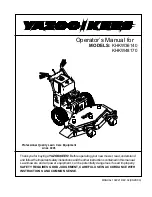
5
s
ectiOn
2 — i
MpOrtant
s
afe
O
peratiOn
p
ractices
Follow the manufacturer’s recommendations for wheel
4.
weights or counterweights to improve stability.
Use extra care with grass catchers or other attachments.
5.
These can change the stability of the machine.
Keep all movement on the slopes slow and gradual. Do
6.
not make sudden changes in speed or direction. Rapid
acceleration or deceleration could cause the front of the
machine to lift and rapidly flip over backwards, which
could cause serious injury.
Do Not:
Do not turn on slopes unless necessary; then turn slowly
1.
uphill and use extra care while turning.
Do not mow near drop-offs, ditches or embankments. The
2.
mower could suddenly turn over if a wheel is over the edge
of a cliff, ditch, or if an edge caves in.
Do not try to stabilize the machine by putting your foot on
3.
the ground.
Do not use a grass catcher on slopes steeper than 15
4.
degrees.
Do not mow on wet grass. Reduced traction could cause
5.
sliding.
Do not tow heavy pull behind attachments (e.g. loaded
6.
dump cart, lawn roller, etc.) on slopes greater than 5
degrees. When going down hill, the extra weight tends
to push the tractor and may cause you to loose control
(e.g. tractor may speed up, braking and steering ability are
reduced, attachment may jack-knife and cause tractor to
overturn).
Children
Tragic accidents can occur if the operator is not alert to the
1.
presence of children under 16 years of age. Children are
often attracted to the machine and the mowing activity.
They do not understand the dangers. Never assume that
children will remain where you last saw them.
Keep children out of the mowing area and in
a.
watchful care of a responsible adult other than the
operator.
Be alert and turn machine off if a child enters the
b.
area.
To avoid back-over accidents, always look behind
c.
and down for small children.
Never carry children, even with the blade(s) shut off.
d.
They may fall off and be seriously injured or interfere
with safe machine operation.
Use extreme care when approaching blind corners,
e.
doorways, shrubs, trees or other objects that may
block your vision of a child who may run into the
path of the machine.
Keep children away from hot or running engines.
f.
They can suffer burns from a hot muffler.
Remove key when machine is unattended to
g.
prevent unauthorized operation.
Ne
2.
ver allow children under 16 years of age to operate this
machine. Children 16 and over should read and understand
the instructions and safe operation practices in this manual
and on the machine and should be trained and supervised
by an adult.
Towing
Do not tow heavy tow-behind attachments (e.g. loaded
1.
dump cart, lawn roller, etc.) on slopes greater than 5
degrees.
Tow only with a machine that has a hitch designed for
2.
towing. Do not attach towed equipment except at the
hitch point.
Follow the manufacturers recommendation for weight
3.
limits for towed equipment and towing on slopes.
Never allow children or others in or on towed equipment.
4.
On slopes, the weight of the towed equipment may cause
5.
loss of traction and loss of control.
Travel slowly and allow extra distance to stop.
6.
Do not shift to neutral and coast downhill.
7.
Transporting Machines
Machines operated on public roads must comply with state
1.
& local ordinances, SAE J137, and AnSI/ASABE S279.
Use care when loading or unloading machines onto trailers
2.
and trucks.
If ramps are used, they must be full width, and secured to
3.
the trailer or truck.
Machines must be secured onto trailers and trucks with
4.
straps, chains, cables, ropes, or other means deemed
adequate for that purpose. The front and rear of the
machines must be secured to the trailer or truck in both the
lateral and vertical directions.
Operator Protective System (OPS)
This machine is equipped with an Operator Protective
1.
System (OPS), which includes:
A Roll Over Protective Structure (ROPS) or Operator
a.
Protective Device (OPD) of the fixed or folding
configuration.
Seat belt assembly with retractable function.
b.
ROPS and OPDs are structures designed to provide a
2.
crush-resistant space for the operator when properly
seat-belted within the designated seating area of the
machine in the event of a machine tip-over or roll-over.
Folding ROPS and OPDs shall be used in their fully upright
and locked configurations except in those circumstances
whereby they need to be momentarily folded-down to
avoid contact with items such as tree limbs, clothes lines,
guy wires, buildings, etc. At other times and conditions,
ROPS and OPDs shall be in their fully upright and locked
configurations.
DANGER:
Damaged ROPS and OPDs must be
replaced prior to operator use!
Seat belts shall be used and shall be properly fastened
3.
about the operator’s waist at all times, except when the
ROPS or OPDs are:
Not properly installed and/or not properly secured
a.
onto the machine.
Содержание S6031 Tank S
Страница 45: ...Notes 12 45...






































